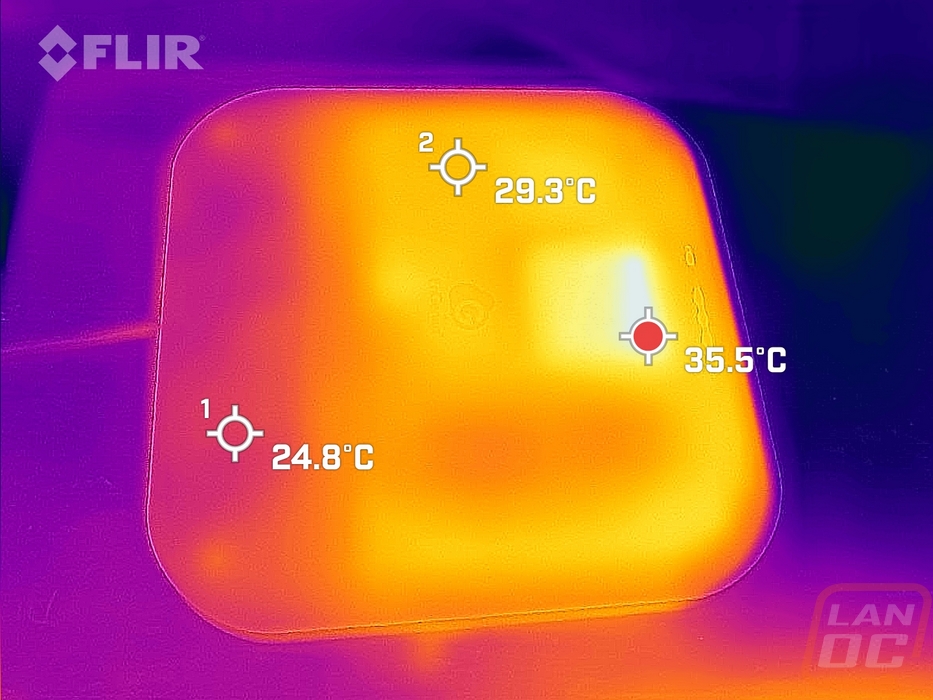Software and Performance
Before jumping into performance testing with the EnGenius ECW336 I did need to get it set up and I wanted to go through the software side of things. The ECW336, like with some of the other EnGenius APs and switches we have taken a look at in the past, supports EnGenius Cloud which puts a majority of your control all together on a cloud-based website or app depending on if you are using it from your PC or phone. This makes setting the ECW336 extremely easy, especially if you already have other EnGenius devices set up like I do. Using the EnGenius Cloud app on the main landing page you have a bright orange plus button in the bottom right corner. Clicking this will let you scan the QR code on the back of the ECW336 to attach it to your already setup network. If you haven’t set one up, it will walk you through the steps. From there you just need to have the ECW336 plugged into a network cable with PoE and once it powers up it will update with your current network settings and work right away.
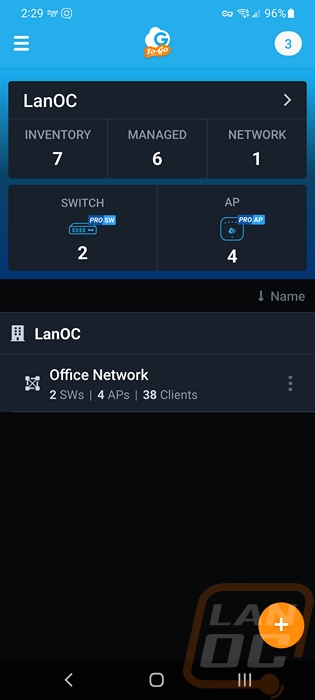
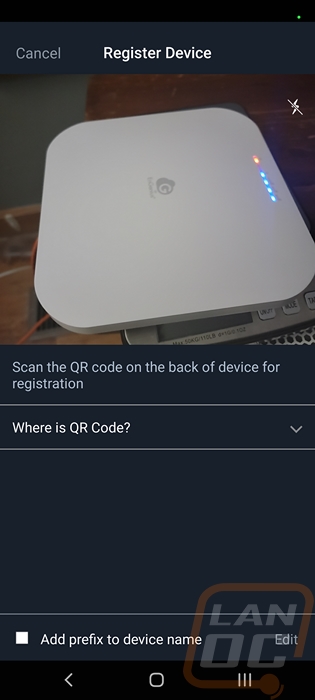
The main landing page on the EnGenius Cloud website has a radar chart right up top that is used to show if you have any current network issues. You can see that our setup doesn’t like our current mix of 2.4,5, and 6 GHz clients because I have a lot of smart devices which all only support 2.4 GHz networks. This can also show if you have any devices down as well. Next to that, they break down the number of each device type online and the total number of clients, each of those can be clicked on to take you into settings for that device type or for a list of clients. Then below that they have your access point throughput for the last day all graphed along with breakdowns of top clients, top access points, top SSIDs, top device OS, and top applications used.


In the top left the menu is hidden until you mouse over the images but they have a listing of management pages, configuration pages, and an analyze page but that only has the event log. Looking back the AirGuard section might be a better fit for the analyze section as well. The configuration section breaks things down by device type and for an access point like the ECW336, you can get into SSID settings or the radio settings.



In the management menu when you click on access points it gives you a full listing of access points that are set up on your network. Each has its name, serial number, mac address, model, uptime, firmware version, WAN and LAN IP, channels, and client quantity listed. You can click and remove any of them from your network here or add more access points as well. Mousing over them also gives you options to see details on that AP, diagnose, reboot, or replace. Clicking on the details opens up a new page with everything about that specific AP listed in even more detail. They list out all of your SSIDs and show you how many clients have been on that SSID in the last five minutes. They also have throughput for that specific AP graphed out. You can get into radio and IP settings if you want to change any of those outside of your overall network settings. You also have access to the device-specific log and a client listing that shows each device attached to the AP with information like its client name, MAC address, IP, SSID, OS, and even signal-to-noise rate.

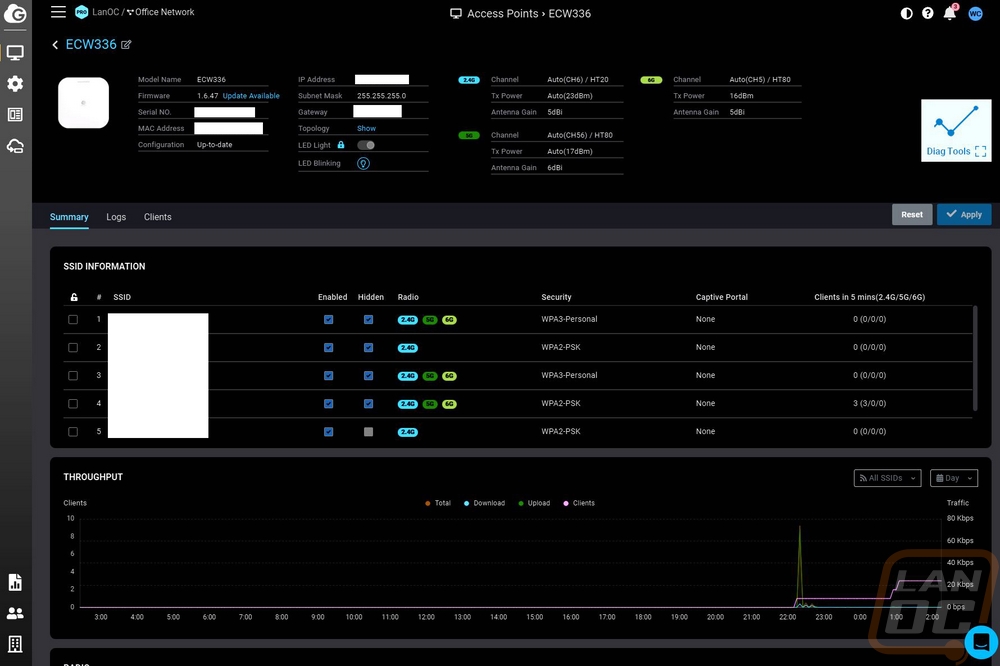



Going back to the access point listing page and mousing over a device again or using the button on the device page called diagnose you can open up the diag tools page. This will full screen on your device. There are four and a half pages here with the extra half being that one page is really two. You have the activity page which graphs out CPU, Memory, Throughput, and channel utilization the entire time you are on the diagnosis page. Next to that is the internet connectivity page which has a speed test that you can run and shows a list of pings to popular websites. You can add more ping locations as well. Expanding on that the next page does traceroutes letting you traceroute directly from the access point. This will list out all of the hops as well as graph it as well up at the top. Then the last page is the channel utilization page which will scan and show how much traffic it finds in each channel. This has pages for 2.4 GHz and 5 GHz and does a good job of visually showing how much more room that 5 GHz opens up.
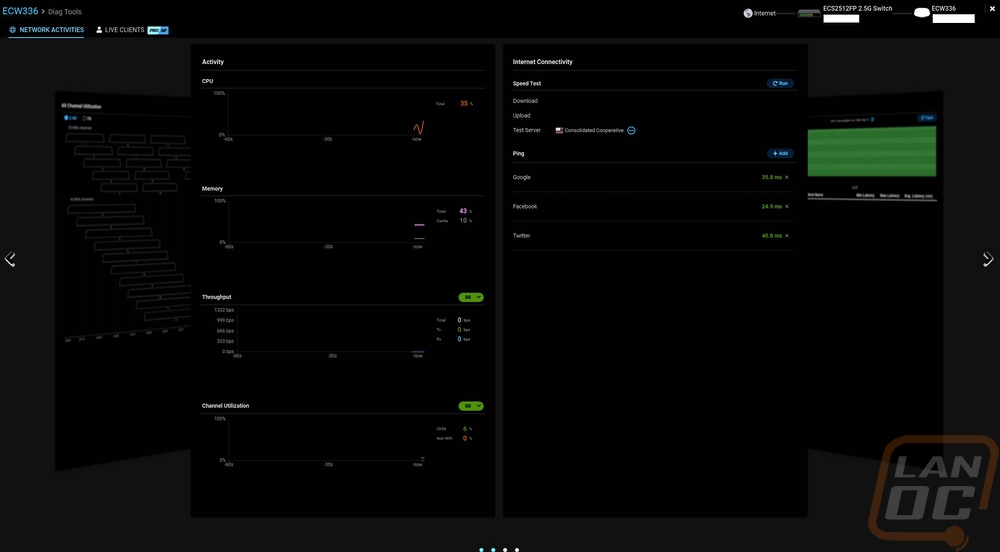
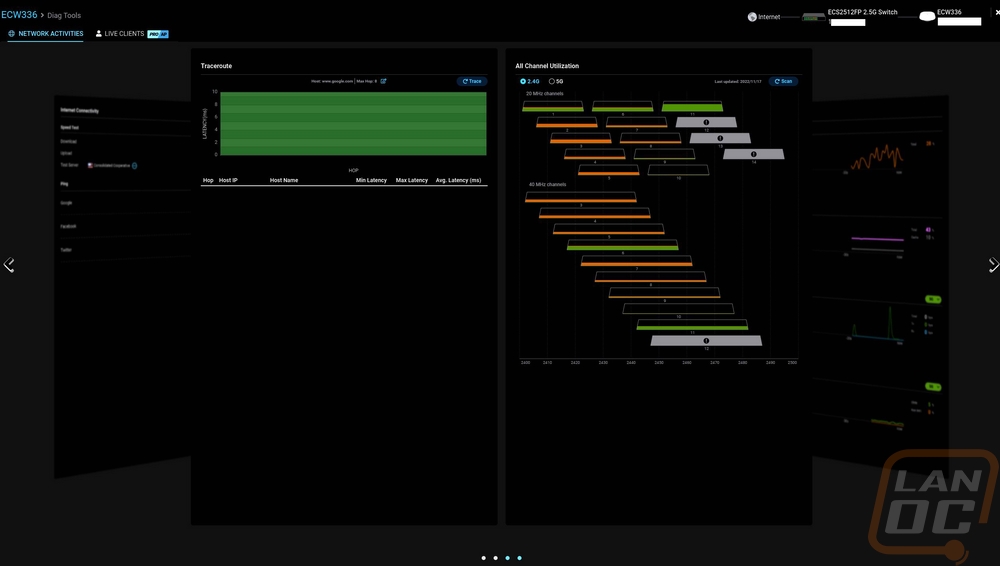
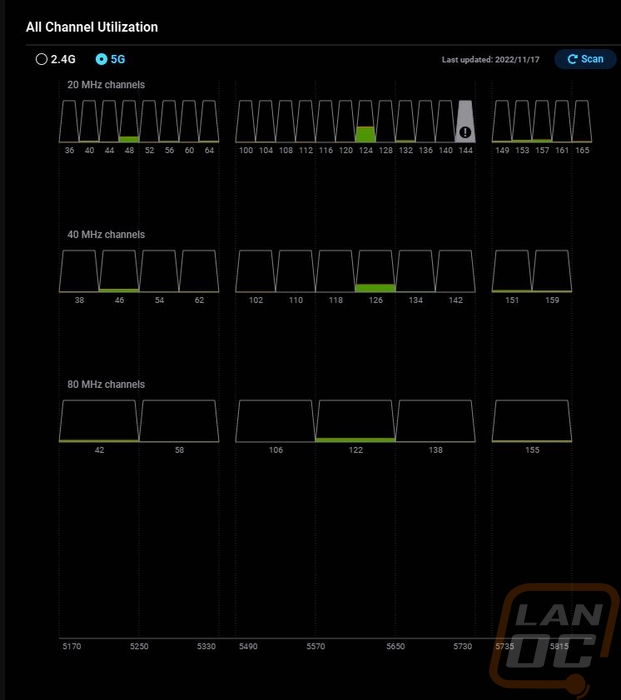
Opening up the SSID page from the configuration menu opens up a complete list of all of the SSIDs that you have set up. The main page gives you a few details like if the SSID is enabled and if it is hidden as well as the security. In the top right, you can click add SSID to create a new one or click on any of your old SSIDs to open up the same page where you can make changes to them. The page has the SSID name up at the top and lets you turn it on and off. You can also limit different radio channels depending on the SSID as well. EnGenius gives you access to all of the modern security types including mixed security like one that does WPA3 when supported and WPA2 when it isn’t which is a great option. Most smart home devices don’t support WPA3 at all even though it provides a lot of security benefits. Below that you can set up the default VLAN specific to the SSID.
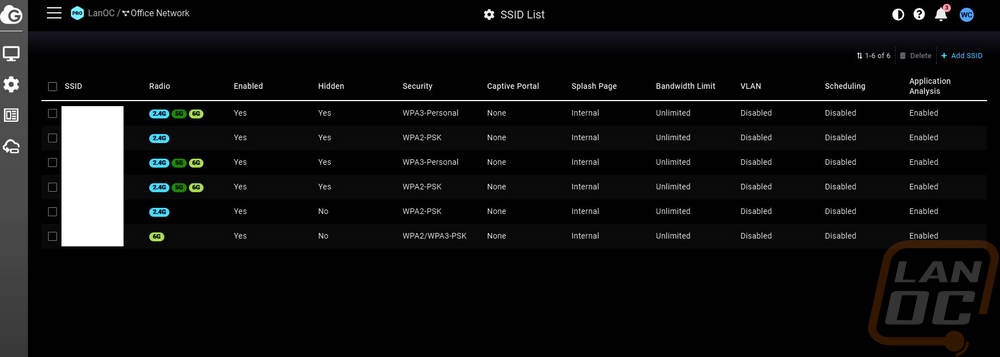
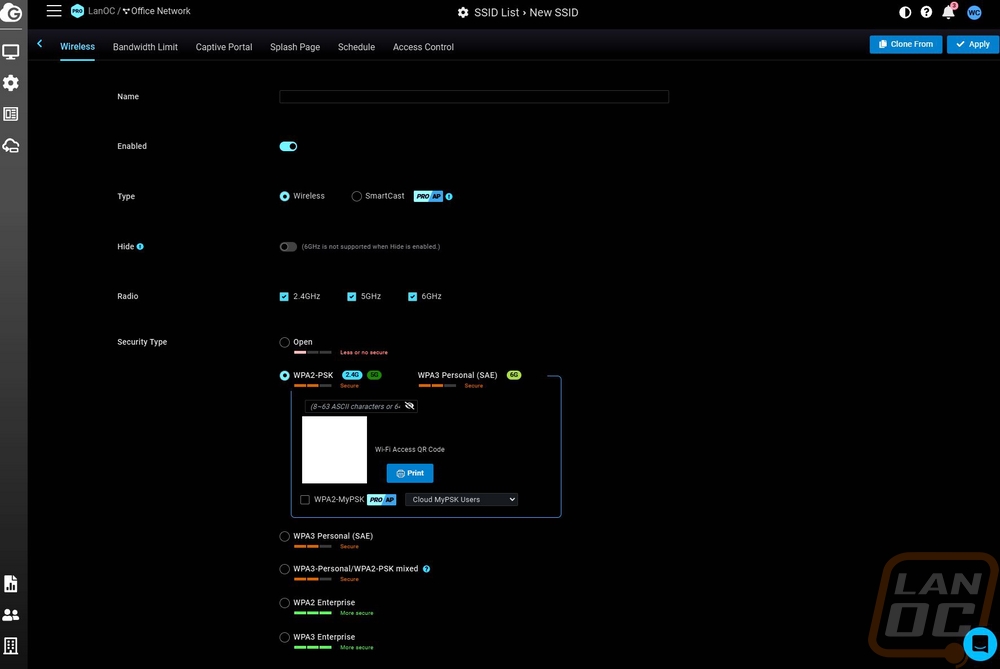
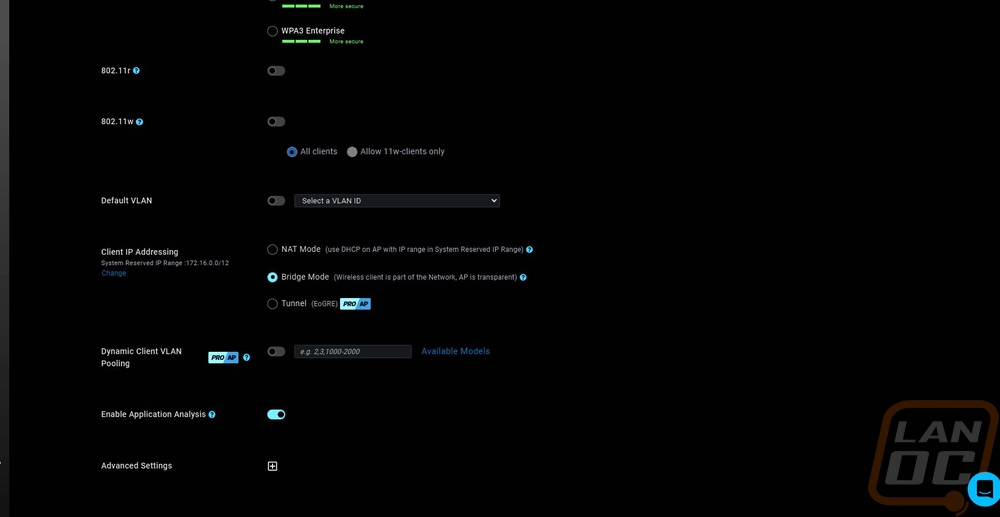
This is where all of the standard settings are and most won't need anything beyond that. Being an enterprise access point however the ECW336 does have a lot more to offer as far as SSID-specific settings. You have a page for setting up the bandwidth limits. You can do this per client or you can set limits for the SSID as a whole. Then there is a page to set up a captive portal which has a long list of authentication options. You can set up a custom redirect URL and they also give you finer detail to change idle and session timeouts. There is a default splash page or you can set up a custom page. Then one of the features I really like is the SSID-specific scheduling. With this, you can turn off guest SSIDs when your business is closed or all of them if you are setting up an office environment or if you are a power user you could use this to block access for kids at specific times. There is also the access control page where you can block specific mac addresses from being on that SSID at all.
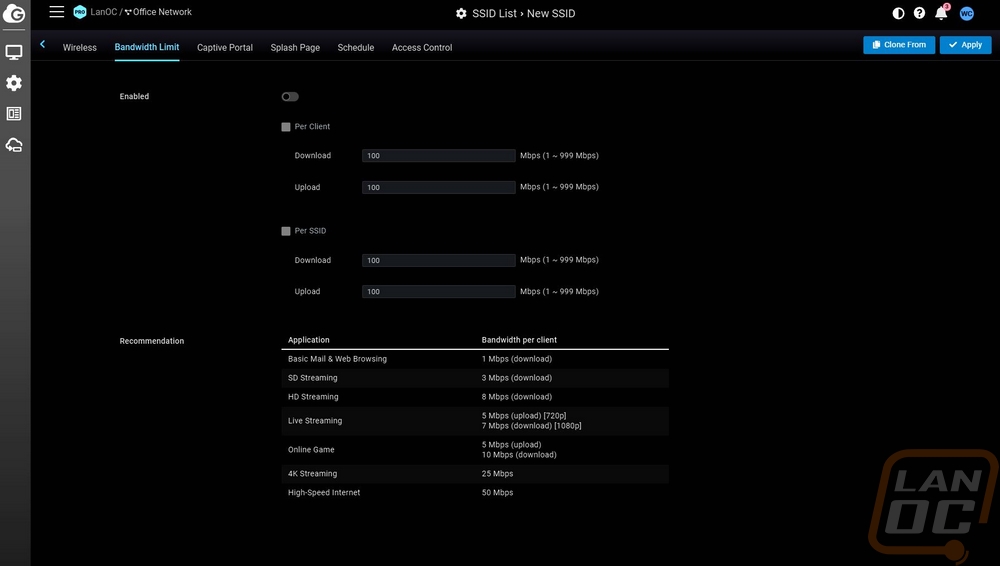
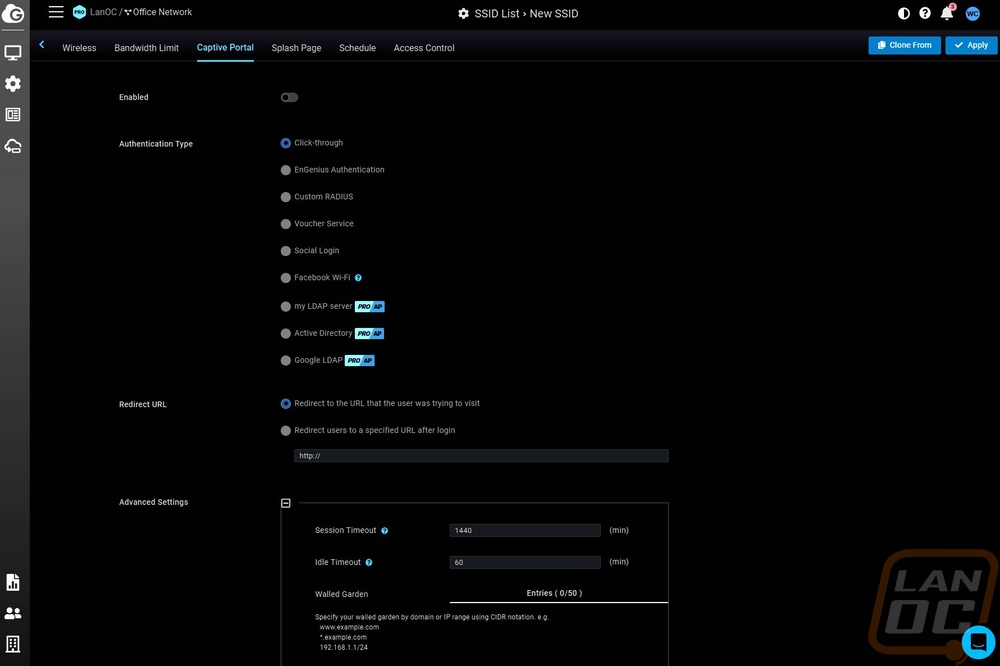
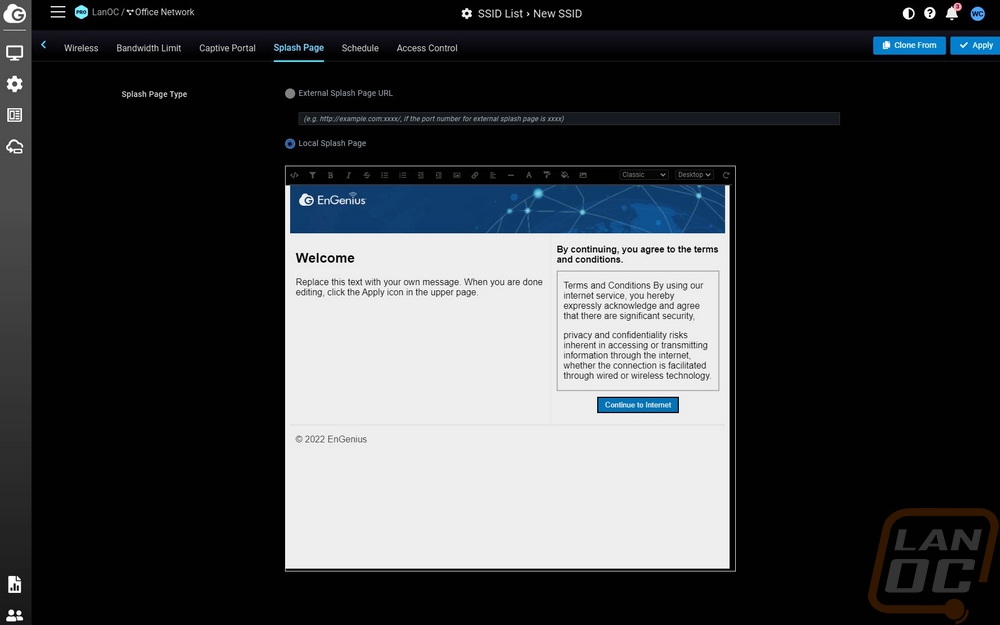
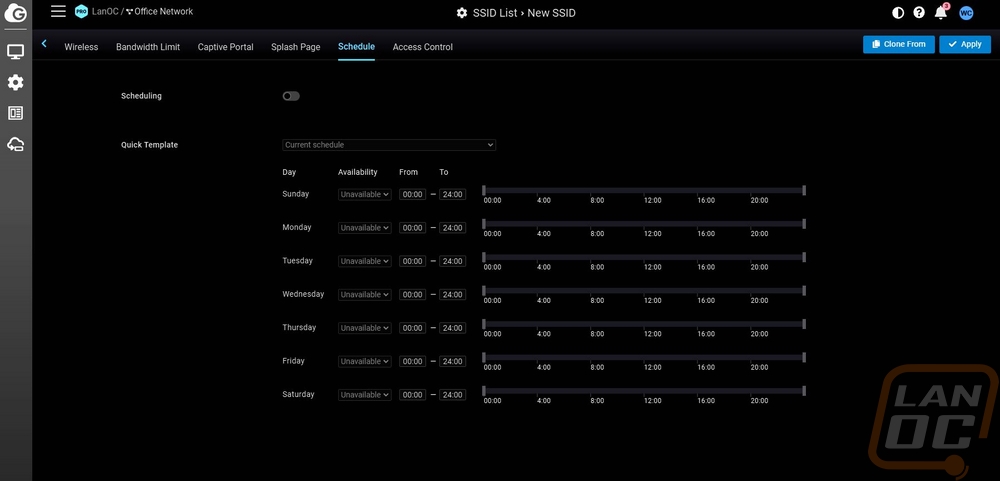
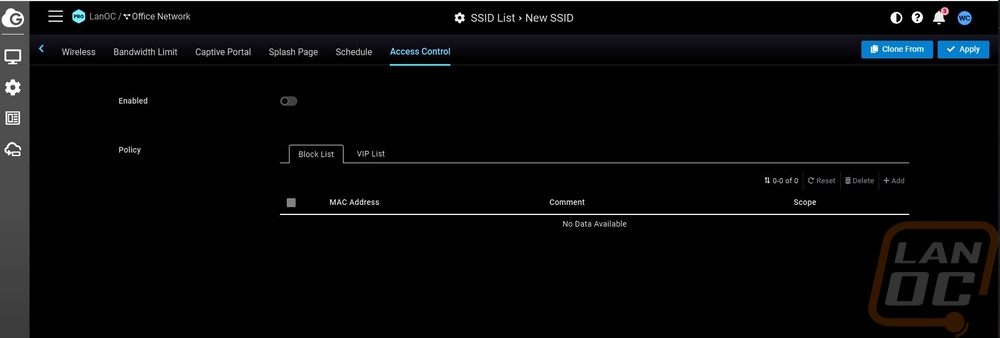
Unlike the SSID section which had everything split across multiple pages, the radio page has everything all together on one screen. There is a lot to take in, especially with the ECW336 supporting 6 GHz. The page is split in half with nearly the same settings on each side. The left is all of the settings for your indoor access points and the right is for outdoor access points letting you have different settings for each situation. Then at the top of each you can turn on or off each of the three frequencies. Below that you have settings per frequency to force a channel if needed or let it auto-select, setting channel width, transmit power, and minimum bitrate. You can also set up limits for the number of clients on each as well. From there you get into mode detailed settings like turning 11AX on or off, and disabling 802.11a/b/g if you want to turn off older legacy wireless. You can turn DCS (Dynamic Channel Switching) on or off depending on the radio as well as change the different modes and also the time limit on that. Then you have client balancing which is good to run to spread them out better across frequencies, I only have this off to keep 5 GHz and 6 GHz open for devices like our phones and PCs while keeping smart devices altogether. You also have the option to turn on wireless mesh but I have that off because all of ours are hard-wired.

Of course, I can’t check out the performance of the EnGenius ECW336 without testing out its wireless performance. With the main change being the move from WiFi 6 to Wifi 6e I wanted to focus on that, specifically testing out the performance difference between 5Ghz and 6Ghz both on the ECW336. I should also point out that these were done with the ECW336 hooked up to a 2.5G network connection, not the 5G network connection that it is capable of. That doesn’t affect its single device performance but could if pushing things with a lot of devices change performance in that situation. I tested the wireless using two different devices and two different tests. My go-to is using Passmark Performance Test 10.2 with its network test. I used our test bench which supports Wifi 6e as the wireless device and test to my PC which is connected to a 10G network connection, both the access point and my PC were wired to the same EnGenius ECS2512FP. The end result was 545.6 Mbps as the best result when connecting via 5Ghz but by switching to 6 GHz I was able to improve that to 849.8 Mbps. I did a similar test using an android app called Wifi speed test while running the test server on the same PC and the app on my Samsung S21 ultra which was one of the first devices to support Wifi 6e. My phone connected at 640 Mbps on 5Ghz and was slower than the PC at 406.18 Mbps. With 6Ghz the link speed was much higher at 1200 Mbps and it tested at 831 Mbps. This is fast enough to max out my 600-700 Mbps internet connection over wireless for the first time and finally giving me real world wired like performance through wireless. Now obviously the connection is capable of a lot more with a single connection being capable of 1200 Mbps and that doesn’t count MU-MIMO which would make 4800 Mbps possible but I’m happy with the significant improvement I’m seeing in real-world performance as it sits. My only complaint is that as of right now the ECW336 can’t hide an SSID while supporting 6Ghz and while hiding an SSID isn’t a big security feature I do prefer to keep mine hidden when possible.
|
|
WiFi 6 (5Gz) |
WiFi 6E (6GHz) |
|
Passmark 10.2 Network Test |
545.6 Mbps |
849.8 Mbps |
|
WiFi test on Samsung S21 Ultra |
406.18 Mbps |
831 Mbps |
|
Phone Link Speed |
640 Mbps |
1200 Mbps |
As far as power usage the ECW336 didn’t do too badly. In the picture below port 8 is the ECW336 and depending on usage I normally see it pulling between 9 and 10.2 watts. The ECW230 is port 6 which I have seen in the same power range as the ECW336 but has peaked a little higher at 11.3 watts. Then lastly is the ECW260 outside AP on port 7 which consistently pulls less in the 6-7 watt range but also has fewer devices running on it. The main takeaway from this is that the ECW336 isn’t pulling noticeably more power than any of our other EnGenius access points but it is rated at a max power of 22.5 watts which is higher than the ECW230 at 19.5 watts, the ECW260 at 15.9 watts and the ECW220S at 12.8 watts.

Before finishing up I did also put the ECW336 in front of our thermal camera. When bench testing it the back side felt very hot any time it was running and these pictures did confirm that. You can see that the back side is five degrees hotter than the front. The back side of the ECW336 is aluminum whereas the front is plastic so that isn’t a surprise at all. Both the included clip-on mounts or using the screw hangers both keep the back of the access point away from your wall or ceiling which will help with airflow to keep things cool. The plastic cover does almost give us a look through the housing, we can see where most of the heat is coming from and it is just behind the status LEDs. The back side shows this as well but the aluminum dissipates that heat out across the surface more.
